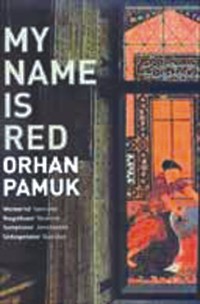|
Book Review
The Name of the Game
JOHN MULLAN analyses My Name is Red
 |
My Name is Red
RRP: £7.99
Publisher: Faber & Faber |
My Name Is Red is in some ways a difficult novel. It is structurally demanding, being divided up between 10 narrators, with interspersed parables offered by several imaginary voices (Death, A Horse, Satan). It is also culturally challenging. Set in Istanbul at the end of the 16th century, it is much concerned with the clash between eastern and western - Islamic and Christian - ideas about art. The anglophone reader is required to imagine the formal delights of the illuminations painted by the miniaturists who are Pamuk's main characters. To them, the aesthetic and religious values informing these (of course invisible) pictures are second nature.
This is a novel of ideas and a meditation on how east and west might meet. It is also an example of what has been a popular genre in recent decades: the historical mystery. Pamuk likes to build his novels around mysteries, making detective stories of intellectual inquiries: The Black Book is about a man whose wife has disappeared; in Snow a journalist investigates a spate of suicides in a remote Turkish town. The main character of My Name is Red, Black, attempts to solve the murders of a court painter and their master, who is also his own uncle. However formally elaborate or philosophically ambitious, the book is - to use that originally dismissive label - a whodunit.
The combination of historical setting and murder mystery will remind many of Umberto Eco's The Name of the Rose (1984). Eco's medieval crime puzzler led us through the byways of antique learning and made the solution of the whodunit depend on a knowledge of medieval literary theory. Comparably, to solve the murders in Pamuk's novel we must find out something about theories of art in the Ottoman court. Pamuk seems to have had Eco's bestseller specifically in mind (and in his title?), for he appears to invite us to use our knowledge of that novel's denouement. We are given every opportunity to believe that the murderer will be a zealot for religious orthodoxy, as in The Name of the Rose. This, it turns out, is a red herring.
Arcane though its learning might have been, The Name of the Rose was but a more elaborate version of an established genre pioneered by Ellis Peters (real name Edith Pargetter), creator of the medieval detective Brother Cadfael. Academics like Eco have been drawn to the genre. Peters's most successful imitator has probably been Candace Robb, a scholar of medieval literature before fiction became a full-time occupation. She has written a series featuring the one-eyed sleuth Owen Archer, set in and around 14th-century York. Rosemary Rowe, author of Roman whodunits, is the pen-name of Rosemary Aitken, an English language academic. Celtic scholar Peter Beresford Ellis is the prolific author of historical murder yarns under the name Peter Tremayne. The best-known are set in 7th-century Ireland and feature a female detective, Sister Fidelina.
There are even historical detective stories for children, notably the Roman Mysteries series by Caroline Lawrence. Each of these includes a lexicon of useful Latin words, for the genre delights in popularising erudition. Literary professor Margaret Ann Doody, author of a series of whodunits set in ancient Athens featuring Aristotle as detective, makes her tales turn on knowledge of ancient mores. Oxford art historian Iain Pears has produced erudite mystery novels, culminating in the bestselling historical whodunit, An Instance of the Fingerpost. Its reader-detective is instructed in the intellectual ferment of 17th-century Oxford.
One might say that Pamuk has attached a novel of ideas to this popular genre for good commercial reasons. Yet his choice of genre is also appropriate. To solve the mystery we follow an inquiry into Islamic art, and how it began to be influenced by western, particularly Venetian, painting. Usually, in historical mysteries, the reader looking for clues is invited to be a kind of archaeologist. In Pamuk's novel you become, more strangely, an archeologist of beliefs. In his melancholy transformation of the genre, his "solution" is troubling rather than satisfying. The murderer has killed because he has been unable to reconcile two ideals of painting - unable to belong to both east and west.
Copyright
(R) thedailystar.net 2010
|

